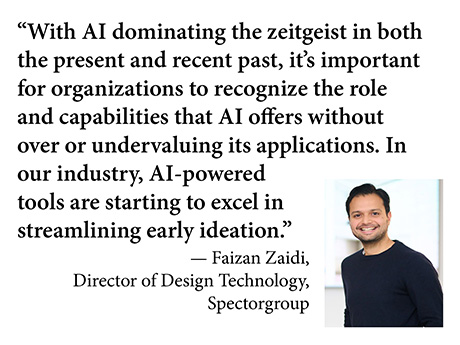By Faizan Zaidi, director of design technology, Spectorgroup
As the commercial real estate market cycles through periods of challenge, savvy owners and investors can leverage advanced technologies to position themselves for growth and mitigate future risks.
Commercial real estate services giant CBRE is predicting a moderate recovery in investment activity throughout 2025, following a near 50 percent drop in office sector valuations in April of 2024, according to data from California-based management firm A Street Partners. As such, the volatility of today’s landscape underscores the importance of long-term strategic planning to navigate shifting market conditions, mitigate risk and position assets for growth.
Today, major advances in technology are helping to streamline project timelines while enhancing decision-making, thus equipping decision-makers with the tools to navigate the ever-evolving building landscape more effectively.

With regard to project deliveries over the past decade, the industry has seen a major shift in key areas of focus. Whereas firms and clients alike were previously concerned primarily with speed of execution and the delivery of the final product, collaborators today are asking how projects are delivered, emphasizing cost-efficiency and the use of proper digital tools. As clients become more discerning, firms must adapt and incorporate more advanced technologies to remain competitive.
Navigating Technology: The Role of 3D Renderings
With an ever-increasing array of technologies available, firms must determine which tools truly enhance their processes rather than adopting new technology simply for the sake of novelty.
The decision to test and eventually incorporate a given piece of technology should evolve naturally from an understanding of specific use cases and the firm’s required client deliverables. This ensures that the tools adopted are refined to better serve client needs, as opposed to muddying existing firm workflows.
As an example, consider the industry’s transition from 2D CAD workflow to a 3D BIM/Revit environment and its second-order effects on 3D visualization. Instead of working with 2D drawings, most projects are now modeled in detailed, interactive 3D spaces, making it easier to visualize, edit and collaborate on designs. As clients began to look for insights to guide early decision-making, the use of 3D modeling emerged as a means of providing immersive, detailed visualizations to understand the look and feel of a space before construction begins.
Compounded with advances in modern hardware, like NVIDIA graphic imaging chips, the industry now has the ability to rapidly iterate, developing renderings and walkthroughs in hours that might previously have taken days or weeks to create. While traditional 3D workflows required exporting and polishing to create a presentable 3D rendering, tools like Revit integrate with connected software to enable real-time design visuals and documentation.
This works to break down the traditionally siloed workflows between individual teams, melding their efforts into a cohesive and collaborative process. The result is a more efficient workflow where architects, designers and engineers can seamlessly share updates, ensure accuracy and align their visions, ultimately leading to faster project completion and better outcomes for clients.
Beyond Visualization: AI’s Role in Early Phasing
No conversation about the use of advanced technologies can ignore the ever-looming presence of generative design and artificial intelligence (AI).
With AI dominating the zeitgeist in both the present and recent past, it’s important for organizations to recognize the role and capabilities that AI offers without over or undervaluing its applications. In our industry, AI-powered tools are starting to excel in streamlining early ideation and concept creation. Whereas previously multiple meetings might have been required to determine early design direction, we’re seeing faster alignment as these tools accelerate decision-making, reduce back-and-forth and allow teams to focus more on refining the final design rather than iterating on preliminary concepts.
But this doesn’t mean the use of AI in the architecture, engineering and construction (AEC) industries is without its own challenges. Major language models, like Open AI’s 4o series models, rely heavily on data trained from the broader internet. This informs the outputs and behavior of these models, with the larger sample size of information allowing for more standardized (and hopefully accurate) responses to relevant queries.
The level of data input from the AEC industry to inform these AI tools is far lower, meaning they generally have less data to train models with. The successful use of AI in real estate will depend largely on the input of internal, proprietary firm data to fill these gaps and create more specialized, context-aware tools.
The Future of Design Technology
Despite those limitations, we can imagine the future potential of AI models trained with AEC-specific data. In the near future, it’s plausible that every major firm will develop proprietary AI tools that are trained using their unique internal data sets and operational insights. These tools will evolve continuously, becoming smarter and more refined with each project they support.
The result? A design process that not only dismantles traditionally siloed information, but also improves the speed, accuracy and quality of client deliverables. These AI systems could advise from vast amounts of proprietary project data, identify inefficiencies and even predict potential challenges, allowing firms to make more informed, proactive decisions.
It’s critical that we view AI as a powerful tool rather than a one-size-fits-all solution. While it offers the promise of innovation, adopting these tools indiscriminately risks disrupting well-established workflows or overshadowing the human expertise that is central to our industry.
Strategic implementation is also key. This means that it is imperative that firms carefully evaluate how AI fits within their existing processes, ensuring it enhances rather than replaces the collaborative, creative problem-solving that defines AEC. By balancing innovation with process integrity, we can utilize AI’s strengths while preserving the human ingenuity that drives meaningful design.
The true potential of these technologies lies in their thoughtful and strategic adoption. Firms that integrate these innovations while preserving the creative and collaborative essence of the design process will not only adapt to the challenges of an uncertain market, but also position themselves to remain competitive in today’s market. In this way, the intersection of human expertise and cutting-edge tools becomes the key to unlocking a more efficient and resilient future for the real estate industry.


